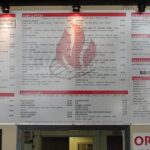In the world of food service, presentation is everything. Whether you run a cozy café, a bustling fast-food joint, or a high-end restaurant, one key element can dramatically impact customer experience, influence sales, and communicate your brand identity—the menu board.
Far beyond being just a display of food and prices, a menu board acts as a silent salesperson, guiding your guests, shaping their choices, and even increasing your profits when designed effectively. Let’s explore why the menu board is one of the most essential tools for any restaurant or food service business.
What Is a Menu Board?
A menu board is a visual display used to present a restaurant’s menu items. These boards come in various forms, including chalkboards, digital screens, lightboxes, printed posters, or wall-mounted panels. Depending on the business type, location, and audience, the style and content of a menu board can vary significantly.
While the traditional use has been to simply show what’s available, today’s menu boards are about creating a dynamic, engaging experience that enhances a customer’s interaction with your brand.
Why Menu Boards Matter
1. First Impressions Count
Your menu board is often one of the first things a customer sees when they walk through the door. A clean, visually appealing, and easy-to-read menu sets the tone for the dining experience. It communicates professionalism, brand personality, and attention to detail—all before your staff says a word.
2. Boosts Efficiency
An effective menu board helps customers make quicker decisions, streamlining the ordering process and reducing wait times. This is particularly crucial in fast-paced environments like fast food outlets, food trucks, or cafés with high customer turnover.
3. Drives Sales
Strategic placement and design can guide customer choices. By highlighting high-margin items, daily specials, or combo deals, you subtly influence buying decisions and increase average ticket size. Research has shown that a well-structured menu board can lead to a 10-15% increase in sales.
4. Improves Brand Identity
Whether it’s sleek digital signage in a modern eatery or a rustic chalkboard in a farm-to-table bistro, your menu board should reflect your brand’s personality. Fonts, colors, language, and layout all work together to reinforce your image and attract your target audience.
Types of Menu Boards
✅ Static Menu Boards
Traditional boards made of chalk, vinyl, or printed panels. These are cost-effective and ideal for businesses with a stable menu. They’re easy to read and add a handcrafted, personal touch when designed creatively.
✅ Digital Menu Boards
These are dynamic screens that can display rotating menus, videos, animations, and promotional content. They’re perfect for fast food chains, cafés, or any venue with frequently changing offerings. Digital boards also allow for real-time updates and remote management.
✅ Backlit Menu Boards
Often used in quick service restaurants, these feature illuminated displays that enhance readability and visual appeal. They’re especially effective in low-light environments or evening operations.
✅ Portable Menu Boards
Used by food trucks, outdoor vendors, or pop-up stalls, these mobile solutions are flexible and easy to update. A-frame boards and tablet stands are popular options for this category.
Best Practices for an Effective Menu Board
To truly harness the power of your menu board, follow these proven tips:
1. Keep It Simple
Don’t overwhelm your customers with too much information. Group items logically (e.g., appetizers, mains, beverages), use concise language, and prioritize readability.
2. Use High-Contrast Colors
Ensure there’s a strong contrast between your background and text. White on black or dark blue on white are popular choices for their readability.
3. Highlight Signature Dishes
Use design elements—boxes, borders, or icons—to draw attention to your most popular or profitable dishes.
4. Incorporate Imagery Wisely
A few well-shot food photos can entice hungry customers, but avoid cluttering the board with too many images. Use visuals to support, not dominate.
5. Stay On-Brand
Match the board’s design with your restaurant’s theme and ambiance. A playful café might use hand-drawn illustrations, while a minimalist bistro may opt for sleek digital displays.
Digital vs. Traditional Menu Boards
When deciding between digital and traditional boards, consider your budget, menu flexibility, and desired aesthetic.
-
Digital boards are ideal for businesses that frequently change their menu or want to showcase multimedia content. They’re modern, flexible, and engaging—but come with a higher initial cost.
-
Traditional boards offer charm, affordability, and a low-tech, personal feel. They’re great for small businesses or establishments with a timeless or rustic vibe.
Some businesses even use a hybrid approach, mixing a permanent menu panel with a digital screen for promotions or updates.
The Role of Menu Boards in Marketing
Don’t underestimate the marketing power of your menu board. You can:
-
Promote loyalty programs and discounts
-
Display social media handles or QR codes for online ordering
-
Highlight seasonal specials
-
Share your story or brand values
Your menu board can turn one-time visitors into repeat customers by offering value, clarity, and personality.
Final Thoughts
In the competitive world of food service, every detail matters—and the menu board is one of the most valuable tools at your disposal. When designed well, it not only informs but also inspires, engages, and sells.
Whether you’re launching a new eatery or refreshing your existing setup, investing time and thought into your menu board design will pay off. After all, the way you present your food is just as important as how it tastes.

